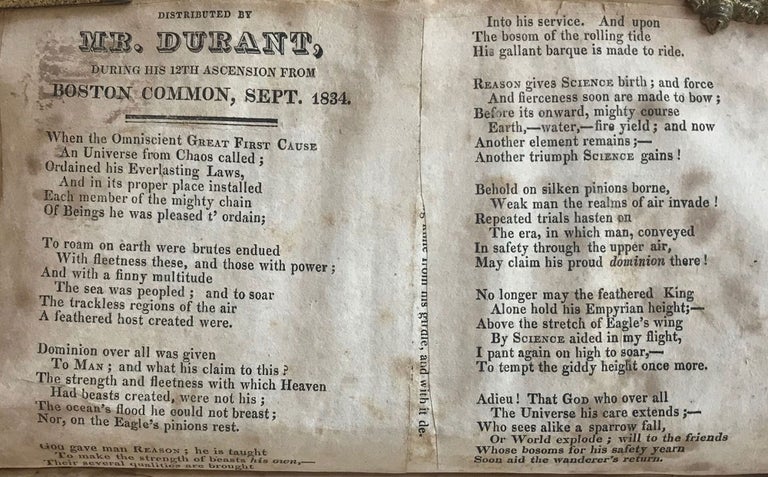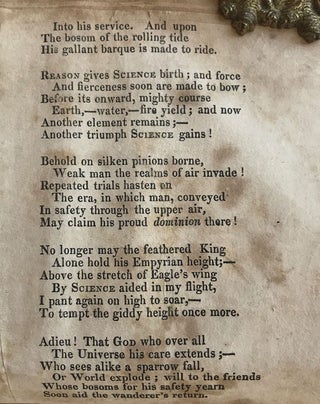Distributed by Mr. Durant, during his 12th ascension from Boston Common, Sept. 1834.
[Boston, September 1834.]. Handbill cut in half, each half measuring 4.5” x 3.75” (the whole originally 9” x 3.75”), mounted on page 68 of the History of the Discovery of America, of the Landing of our Forefathers, at Plymouth…8vo (8” x 5.25”), used here as a scrapbook. The handbill is blank on the verso (as evident when held up to the light), indicating that it is not a newspaper or magazine clipping or taken from some other source. CONDITION: Handbill spotted, apparently from adhesive on verso; front cover of book detached. An apparently unrecorded ballooning handbill distributed by “America’s first aeronaut,” featuring a poem celebrating man’s use of reason to achieve flight. Born in New York, Charles F. Durant (1805–1873) was eighteen years old on 9 July 1824 when he witnessed French aeronaut Eugene Robertson make a balloon ascension in honor of the Marquis de Lafayette at Castle Garden in New York. Upon witnessing the event Durant became so enthusiastic that he befriended Robertson and followed him to Paris. The pair made two ascensions together in France in 1829. Encouraged by his experiences, Durant then returned to New York, where he became the first professional American aeronaut. He made his first ascent in 1830, and several thereafter, at Castle Garden in New York. Over the course of his ballooning career Durant made a total of thirteen ascents, blending science with spectacle. Known to have first dropped handbills from his balloon in New York in 1831, Durant has been identified as the “father of the air leaflet.” In 1834 he made a series of three flights from Boston. The present ascension was originally scheduled for 10 September, but because of bad weather was postponed three times until it finally took place on the 13th Two months earlier, on 31 July, Durant dropped handbills featuring a poem by W. Haydon, Jr., suggesting that Haydon may have written the present poem as well. Beginning with an invocation of the creation of the universe and life on earth, the poem extolls aviation as science’s most recent triumph. The eight stanzas read as follows: When the Omniscient Great First Cause / An Universe from Chaos called; / Ordained his Everlasting Laws, / And in its proper place installed / Each member of the mighty chain / Of Beings he was pleased t’ ordain; To roam on earth were brutes endued / With fleetness these, and those with power; / And with a finny multitude / The sea was peopled; and to soar / The trackless regions of the air / A feathered host created were. Dominion over all was given / To Man; and what his claim to this? / The strength and fleetness with which Heaven / Had beasts created were not his; / The ocean’s flood he could not breast; / Nor, on the Eagle’s pinions rest. God gave man Reason; he is taught / To make the strength of beasts his own,— / Their several qualities are brought / Into his service. And upon / The bosom of the rolling tide / His gallant barque is made to ride. Reason gives Science birth; and force / And fierceness soon are made to bow; / Before its onward, mighty course / Earth,—water, —fire yield; and now / Another element remains;— / Another triumph Science gains! Behold on silken pinions borne, / Weak man the realms of air invade! / Repeated trials hasten on / The era, in which man, conveyed / In safety through the upper air, / May claim his proud dominion there! No longer may the feathered King / Above the stretch of Eagle’s wing / By Science aided in my flight, / I pant again on high to soar,— / To tempt the giddy height once more. Adieu! That God who over all / The Universe his care extends;— / Who sees alike a sparrow fall, / Or World explode; will to the friends / Whose bosoms for his safety yearn / Soon aid the wanderer’s return. Nearly 40,000 persons reportedly witnessed the September 13th ascension. Seats for six or seven thousand persons were constructed at Durant's expense and arranged in amphitheater form. During the ascent, Durant brought the balloon close enough to the ground, about ten miles from Boston, that he could speak to a man. In a subsequent account of the incident, Durant noted: “In coming down in Waltham, [Mass.] I gave him some evening papers which I found in the car, directed to gentlemen and newspaper offices in different parts of the United States. I requested he would put them in the post office which he promised to do.” After this, the balloonist dropped ballast and rose again to an altitude of one and a half miles, finally landing near Lincoln, Mass. Durant is thought to have first carried addressed dispatches via balloon and accomplished their delivery to the nearest post office (for re-dispatch) on his immediately preceding ascension, on 31 July 1834—possibly the first air express dispatch in the U.S. During the same ascension he also dropped a basket rigged with a parachute and holding a living rabbit, which came down safely near Old Town, Mass. No copies of this handbill are recorded in OCLC. A fascinating survival from a historic balloon ascension by America’s first aeronaut and “father of the air leaflet.” REFERENCES: Kronstein, Max. “Durant Pioneered Aerial Dispatches in Boston Flights,” Airpost Journal, Vol. XVI, No. 6, (March 1945), pp. 194–198.
Item #7913
Sold




